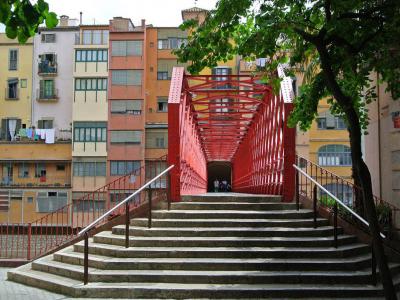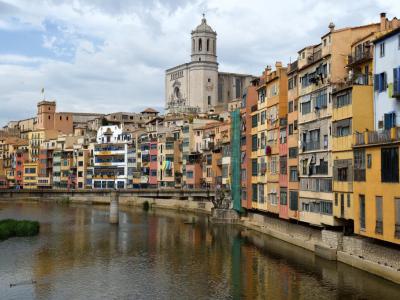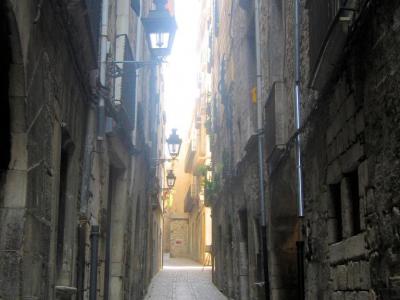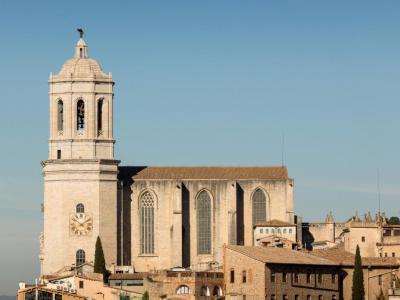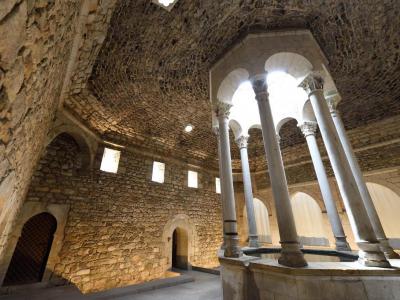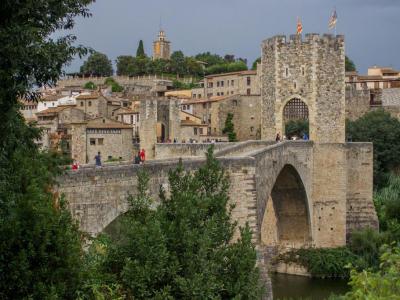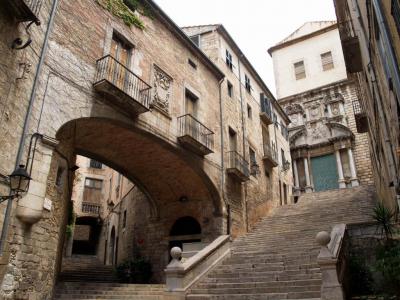Custom Walk in Girona, Spain by jessatkin_db367 created on 2024-10-20
Guide Location: Spain » Girona
Guide Type: Custom Walk
# of Sights: 13
Tour Duration: 2 Hour(s)
Travel Distance: 2.1 Km or 1.3 Miles
Share Key: 9JMBB
Guide Type: Custom Walk
# of Sights: 13
Tour Duration: 2 Hour(s)
Travel Distance: 2.1 Km or 1.3 Miles
Share Key: 9JMBB
How It Works
Please retrieve this walk in the GPSmyCity app. Once done, the app will guide you from one tour stop to the next as if you had a personal tour guide. If you created the walk on this website or come to the page via a link, please follow the instructions below to retrieve the walk in the app.
Retrieve This Walk in App
Step 1. Download the app "GPSmyCity: Walks in 1K+ Cities" on Apple App Store or Google Play Store.
Step 2. In the GPSmyCity app, download(or launch) the guide "Girona Map and Walking Tours".
Step 3. Tap the menu button located at upper right corner of the "Walks" screen and select "Retrieve custom walk". Enter the share key: 9JMBB
1) Mercado del Leo (Lion Market)
Mercado del Leo (Lion Market) is a work of the municipality of Girona included in the Inventory of the Architectural Heritage of Catalonia.
The building responds to the need to centralize the entire range of food products in one space. It has a rectangular ground floor, with austere facades and four entrances, one on each side. It constitutes one of the few examples in Girona of official construction carried out with a fully avant-garde language, although its execution, in the midst of the post-war period, was mediated by the intervention of the municipal architect Gordillo Nieto, who masked the work with addition of decorative heraldic elements. The interior is distributed in different streets that host the traders' stalls. Windows and openings present shapes reminiscent of rationalist architecture.
The building responds to the need to centralize the entire range of food products in one space. It has a rectangular ground floor, with austere facades and four entrances, one on each side. It constitutes one of the few examples in Girona of official construction carried out with a fully avant-garde language, although its execution, in the midst of the post-war period, was mediated by the intervention of the municipal architect Gordillo Nieto, who masked the work with addition of decorative heraldic elements. The interior is distributed in different streets that host the traders' stalls. Windows and openings present shapes reminiscent of rationalist architecture.
Sight description based on Wikipedia.
2) Pont de les Peixateries Velles (Eiffel Bridge) (must see)
Spanning across the Onyar River is one of Girona's most famous bridges, the Bridge of the Old Fishmongers (Pont de les Peixateries Velles) — sometimes called the Bridge of Red Levers (Palanques Vermelles Bridge). It is more commonly referred to as the Eiffel Bridge after the engineer that designed and built it, Gustave Eiffel. Eiffel is most well-known for his important work on the Eiffel Tower, an iconic landmark in Paris, France.
The construction of the Eiffel Bridge took place in 1877. The iron bridge is distinguished by its latticework design that forms an ornate grid-like framework over the top and sides of the bridge. It is painted in a deep brick-red color that is eye-catching. The bridge's width is less than nine feet, and its length across the river is about 136 feet. The floor of the bridge is paved with wooden planks to prevent rusting.
Crossing over this narrow footbridge offers fabulous river views. The picturesque, brightly-colored houses that line the Onyar River are charming. Across the bridge, near the right bank of the river, you'll find the bustling Rambla of Freedom (Rambla de la Llibertat). It is a popular pedestrian-only street that offers shopping and dining in the old town area. On the left bank is the more modern section of Girona, where a stroll up Santa Clara Street (Carrer de Santa Clara) will take you to Girona's lively Independence Square.
The Eiffel Bridge is an impressive structure that is a must-see on your tour around Girona. Head up the steps at either end of the bridge and stroll across it. You'll want to stop along the way to look at the view — and take advantage of the great photo opportunities while you're there!
The construction of the Eiffel Bridge took place in 1877. The iron bridge is distinguished by its latticework design that forms an ornate grid-like framework over the top and sides of the bridge. It is painted in a deep brick-red color that is eye-catching. The bridge's width is less than nine feet, and its length across the river is about 136 feet. The floor of the bridge is paved with wooden planks to prevent rusting.
Crossing over this narrow footbridge offers fabulous river views. The picturesque, brightly-colored houses that line the Onyar River are charming. Across the bridge, near the right bank of the river, you'll find the bustling Rambla of Freedom (Rambla de la Llibertat). It is a popular pedestrian-only street that offers shopping and dining in the old town area. On the left bank is the more modern section of Girona, where a stroll up Santa Clara Street (Carrer de Santa Clara) will take you to Girona's lively Independence Square.
The Eiffel Bridge is an impressive structure that is a must-see on your tour around Girona. Head up the steps at either end of the bridge and stroll across it. You'll want to stop along the way to look at the view — and take advantage of the great photo opportunities while you're there!
3) Onyar River Colored Houses (must see)
Alongside the Onyar River that crosses the city of Girona are rows of brightly colored houses painted in eye-catching shades of ochre, brown, brick red, rich oranges, and yellows. In the later 20th century, a small team of artists and architects selected the color palette for the house's facades.
These structures offer a feast for the eyes as you stroll along the river banks or wander over one of the bridges that cross the river. The river divides the newer part of the city on the west bank from the old town area on the east bank.
These picturesque houses that line the river are sometimes known as the Hanging Houses (Le Casas Penjades). One of these river houses is a must-see tourist attraction, Masó House (Casa Masó), a historic structure that was the family home of Rafael Masó, an acclaimed Catalan architect.
The view of these colorful houses is one of the most iconic images of Girona, often seen in photographs showcasing this beautiful city. One of the best ways to see them is from one of the bridges spanning across the Onyar River, all offering splendid vantage points.
These structures offer a feast for the eyes as you stroll along the river banks or wander over one of the bridges that cross the river. The river divides the newer part of the city on the west bank from the old town area on the east bank.
These picturesque houses that line the river are sometimes known as the Hanging Houses (Le Casas Penjades). One of these river houses is a must-see tourist attraction, Masó House (Casa Masó), a historic structure that was the family home of Rafael Masó, an acclaimed Catalan architect.
The view of these colorful houses is one of the most iconic images of Girona, often seen in photographs showcasing this beautiful city. One of the best ways to see them is from one of the bridges spanning across the Onyar River, all offering splendid vantage points.
4) Jewish Quarter and Jewish History Museum (must see)
The Jewish Quarter of Girona is a magnificent maze of cobbled alleyways lined with medieval stone buildings. Along the narrow streets, ancient stone stairways, and arched passageways, you'll find dozens of small shops, restaurants, coffee houses, and inviting courtyards situated amid the historic structures.
This neighborhood dates from the 12th century and is known as one of Europe's most well-preserved Jewish quarters. At one time, Jews in medieval Girona were actually forbidden from living outside El Call. The area was home to the Jewish community of Girona until 1492 when those that refused to convert to Catholicism were expelled from Spain.
The Museum of Jewish History (Museu d'Història dels Jueus) is housed in a renovated building that was once a medieval synagogue. In the museum's beautiful courtyard is a large Star of David. The museum features 11 exhibition spaces showcasing the history, religion, and culture of the Jewish community of medieval Catalonia and the city of Girona.
The Jewish History Museum features artifacts and displays relating to the origins, family life, and occupations of the Jewish community in Girona. Don't miss the three-dimensional model of the Jewish Quarter. The museum also offers temporary exhibits and a specialty shop with books, gifts, and souvenirs.
This neighborhood dates from the 12th century and is known as one of Europe's most well-preserved Jewish quarters. At one time, Jews in medieval Girona were actually forbidden from living outside El Call. The area was home to the Jewish community of Girona until 1492 when those that refused to convert to Catholicism were expelled from Spain.
The Museum of Jewish History (Museu d'Història dels Jueus) is housed in a renovated building that was once a medieval synagogue. In the museum's beautiful courtyard is a large Star of David. The museum features 11 exhibition spaces showcasing the history, religion, and culture of the Jewish community of medieval Catalonia and the city of Girona.
The Jewish History Museum features artifacts and displays relating to the origins, family life, and occupations of the Jewish community in Girona. Don't miss the three-dimensional model of the Jewish Quarter. The museum also offers temporary exhibits and a specialty shop with books, gifts, and souvenirs.
5) Catedral de Girona (Girona Cathedral) (must see)
A massive grand staircase leads up to the entranceway of the Girona Cathedral, a spectacular cathedral with origins dating to the 11th century. This Roman Catholic church is an impressive structure situated at a high point of the city. The cathedral is also known as the Cathedral of Saint Mary of Girona.
Construction took place until the 18th century; the cathedral's design features a blend of Romanesque, Gothic, and Baroque architecture. Girona Cathedral is famous for its Gothic nave. With a width of 75 feet, it's the second widest church nave in the world. The interior boasts lovely stained glass windows, rose windows, and an ornate Gothic altarpiece, made of gilded silver and gemstones. There are also several side chapels.
The church's eye-catching bell tower rises prominently above the city's skyline. It boasts a clock and a belfry. Located on the north side is the cathedral's trapezoidal-shaped Romanesque cloister. Dating from the 12th century, it features a courtyard surrounded by beautiful colonnades with double-columned arches.
The cathedral treasury features a museum highlighted by the "Tapestry of Creation," an exceptional piece of needlework depicting biblical scenes. This art piece was handcrafted between the 11th and 12th centuries. There is also an illuminated manuscript from the 10th century called the "Gerona Beatus." One of the museum's oldest pieces is the gilded silver casket of Hisham II, dating from the 10th century.
The Girona Cathedral offers regular worship services that include daily Mass. This stone structure is a must-see historical landmark on your tour around the old town area of Girona.
Construction took place until the 18th century; the cathedral's design features a blend of Romanesque, Gothic, and Baroque architecture. Girona Cathedral is famous for its Gothic nave. With a width of 75 feet, it's the second widest church nave in the world. The interior boasts lovely stained glass windows, rose windows, and an ornate Gothic altarpiece, made of gilded silver and gemstones. There are also several side chapels.
The church's eye-catching bell tower rises prominently above the city's skyline. It boasts a clock and a belfry. Located on the north side is the cathedral's trapezoidal-shaped Romanesque cloister. Dating from the 12th century, it features a courtyard surrounded by beautiful colonnades with double-columned arches.
The cathedral treasury features a museum highlighted by the "Tapestry of Creation," an exceptional piece of needlework depicting biblical scenes. This art piece was handcrafted between the 11th and 12th centuries. There is also an illuminated manuscript from the 10th century called the "Gerona Beatus." One of the museum's oldest pieces is the gilded silver casket of Hisham II, dating from the 10th century.
The Girona Cathedral offers regular worship services that include daily Mass. This stone structure is a must-see historical landmark on your tour around the old town area of Girona.
6) Plaza de la Catedral de Girona (Girona Cathedral Square)
Plaza de la Catedral de Girona (Girona Cathedral Square) is a very small, rectangular space. It follows a slight slope and does not present any sculptural or natural elements. The pavement consists of cobblestones.
All the buildings surrounding the square deserve a detailed study due to their quality or history. Primitively, the square of the Cathedral was another point on a long road that allowed the land transit of men from beyond the mountains to the interior of the peninsula (the Via Augusta in Roman times). In the fifth century a chapel, called Sant Genís, was located west of the staircase in front of the house where the Arc bar is today. The chapel was owned by the monastery of Sant Pere de Roda according to a bull of Pope Benedict VI. In 1604 it was demolished and its roof tiles used for the Seu work.
However, there was another chapel built in the Romanesque period. It was the temple of Santa Maria de les Puelles, mentioned in a document from the year 1083 and which was located on the other side of the square, inside the old Palau de Justícia de Girona or Casa Pastors, near the wall of the Ballesteries. In 1245 a brotherhood had been established in the chapel; in 1401 the existence of two altars is known, one dedicated to Santa Maria and the other to Sant Martí. Its demolition took place in 1724.
All the buildings surrounding the square deserve a detailed study due to their quality or history. Primitively, the square of the Cathedral was another point on a long road that allowed the land transit of men from beyond the mountains to the interior of the peninsula (the Via Augusta in Roman times). In the fifth century a chapel, called Sant Genís, was located west of the staircase in front of the house where the Arc bar is today. The chapel was owned by the monastery of Sant Pere de Roda according to a bull of Pope Benedict VI. In 1604 it was demolished and its roof tiles used for the Seu work.
However, there was another chapel built in the Romanesque period. It was the temple of Santa Maria de les Puelles, mentioned in a document from the year 1083 and which was located on the other side of the square, inside the old Palau de Justícia de Girona or Casa Pastors, near the wall of the Ballesteries. In 1245 a brotherhood had been established in the chapel; in 1401 the existence of two altars is known, one dedicated to Santa Maria and the other to Sant Martí. Its demolition took place in 1724.
Sight description based on Wikipedia.
7) Sant Pere de Galligants Cloister - King's Landing Cloister
The Sant Pere de Galligants is a former Benedictine abbey in Girona, and it has been home to the Archaeology Museum of Catalonia since 1857. The place's name translates as "Saint Peter of Galligants" and refers to the river Galligants that runs nearby.
The monastery was built in 992, outside the walls of Girona, and to date, apart from its church and cloister, almost nothing else has survived. The Romanesque church was built in 1130, funded by the lavish donation bequeathed by Ramon Berenguer the Great, Count of Barcelona.
The small cloister that we see today is the perfect example of Catalan Romanesque architecture. Its northern gallery dates back to 1154, while the rest of it is from 1190. The capitals of the columns feature motifs very similar to those found in the cloisters of Sant Cugat del Vallès or in the Cathedral of Girona, depicting scenes from the life of Jesus and some typically Romanesque embellishments such as the images of lions and sirens. In 1931, the site was declared a national monument.
In more recent history, however, the sanctuary gained popularity as a filming set of Game of Thrones. The fiction series featured the monastery on several occasions, primarily as the entrance to the Library of Oldtown, the center of knowledge of the great masters of Ponent, in which Samwell Tarly, accompanied by Gilly and little Sam, wanted to train as a Maester. Another of Sant Pere's peculiar appearances in Game of Thrones was as the King’s Landing Cloister.
The monastery was built in 992, outside the walls of Girona, and to date, apart from its church and cloister, almost nothing else has survived. The Romanesque church was built in 1130, funded by the lavish donation bequeathed by Ramon Berenguer the Great, Count of Barcelona.
The small cloister that we see today is the perfect example of Catalan Romanesque architecture. Its northern gallery dates back to 1154, while the rest of it is from 1190. The capitals of the columns feature motifs very similar to those found in the cloisters of Sant Cugat del Vallès or in the Cathedral of Girona, depicting scenes from the life of Jesus and some typically Romanesque embellishments such as the images of lions and sirens. In 1931, the site was declared a national monument.
In more recent history, however, the sanctuary gained popularity as a filming set of Game of Thrones. The fiction series featured the monastery on several occasions, primarily as the entrance to the Library of Oldtown, the center of knowledge of the great masters of Ponent, in which Samwell Tarly, accompanied by Gilly and little Sam, wanted to train as a Maester. Another of Sant Pere's peculiar appearances in Game of Thrones was as the King’s Landing Cloister.
8) Galligants Bridge - Braavos Bridge
Located between Plaça dels Jurats and the Sant Pere de Galligants Abbey, the Galligants bridge, a monumental piece of stonework, is named after the eponymous river (the Galligants), which is one of the four rivers running through the city. Nowadays, the river is only 4.5 km long, which makes it hard to believe that, back in the old days, it caused one of the worst floods in Girona's history – up to four meters high! – in which the neighborhoods of Sant Pere and de la Barca were washed away completely.
An integral part of Girona's Old Town, this arch bridge is perhaps the most beautiful of all overpasses built on the Galligants watercourse. Ironically, however, today you can't see any water underneath it, for it's been channeled out of this part of town.
Still, this fact alone didn't stop the makers of Game of Thrones from using this bridge as a key location for their shooting of episode seven of the sixth season of the series. Here, Arya Stark (played by Maisie Williams) is seen observing a sculpture in the distance and contemplating her situation after booking her passage home. She is then stabbed by a forlorn girl masked as an old woman.
To make the Galligant Bridge look scenic, considerable CGI effects had to be used. In particular, the landscape that the character is looking at, including a 400-foot tall statue of the Titan of Braavos guarding the harbor, was entirely computer-generated. And while the actual scene of Arya in the water was filmed in a harbor in Northern Ireland, being here you can still capture the feel for this Game of Thrones Girona landmark.
An integral part of Girona's Old Town, this arch bridge is perhaps the most beautiful of all overpasses built on the Galligants watercourse. Ironically, however, today you can't see any water underneath it, for it's been channeled out of this part of town.
Still, this fact alone didn't stop the makers of Game of Thrones from using this bridge as a key location for their shooting of episode seven of the sixth season of the series. Here, Arya Stark (played by Maisie Williams) is seen observing a sculpture in the distance and contemplating her situation after booking her passage home. She is then stabbed by a forlorn girl masked as an old woman.
To make the Galligant Bridge look scenic, considerable CGI effects had to be used. In particular, the landscape that the character is looking at, including a 400-foot tall statue of the Titan of Braavos guarding the harbor, was entirely computer-generated. And while the actual scene of Arya in the water was filmed in a harbor in Northern Ireland, being here you can still capture the feel for this Game of Thrones Girona landmark.
9) Banos Arabes (Arab Baths) (must see)
Not far from the Girona Cathedral, you'll find the Arab Baths. This public bathhouse is a remarkably preserved stone structure. Christians constructed the facility in 1194. Medieval Muslim baths and the baths of ancient Rome were the inspiration for the Arab Baths, though the architectural style is mostly Romanesque.
Visitors can explore the five rooms of the Arab Baths on a self-guided tour. The first room you enter, perhaps the grandest, is the apodyterium or dressing room. It was a place used for changing clothes and socializing. The cold room, known as the frigidarium, was enclosed by two double doors to keep the bath water cold. It was meant to be used at the end of a bathhouse visit.
Next, you'll find the warm room called the tepidarium. This room was a place that boasted more comfortable temperatures for relaxing, conversing, or enjoying a meal. The caldarium was the hottest room, similar to a hot sauna or steam room. In the adjoining furnace room, an ancient central heating system known as a hypocaust helped heat the caldarium and keep it steamed up!
The establishment functioned as a bath until its closure in the 15th century. Thenceforth, it had passed into private hands and been put to different uses. In 1617, a Capuchin convent used the building as a pantry, kitchen, and laundry. Throughout the 19th century, the term “Arab Baths” got firmly attached to the site.
More recently, the baths gained fame as The Baths of Braavos featured in the acclaimed Game of Thrones series. One of the prevalent themes in season six is the hunting of Arya Stark by the waif. You may remember the iconic chase scene through the city which culminates in a terrifying climax. At one point, while fleeing from the waif, Arya ends up entering the baths, trying to hide.
When in here, make sure to pay a visit to the rooftop as you will enjoy some truly incredible views from up there, including the stone-domed skylight.
Visitors can explore the five rooms of the Arab Baths on a self-guided tour. The first room you enter, perhaps the grandest, is the apodyterium or dressing room. It was a place used for changing clothes and socializing. The cold room, known as the frigidarium, was enclosed by two double doors to keep the bath water cold. It was meant to be used at the end of a bathhouse visit.
Next, you'll find the warm room called the tepidarium. This room was a place that boasted more comfortable temperatures for relaxing, conversing, or enjoying a meal. The caldarium was the hottest room, similar to a hot sauna or steam room. In the adjoining furnace room, an ancient central heating system known as a hypocaust helped heat the caldarium and keep it steamed up!
The establishment functioned as a bath until its closure in the 15th century. Thenceforth, it had passed into private hands and been put to different uses. In 1617, a Capuchin convent used the building as a pantry, kitchen, and laundry. Throughout the 19th century, the term “Arab Baths” got firmly attached to the site.
More recently, the baths gained fame as The Baths of Braavos featured in the acclaimed Game of Thrones series. One of the prevalent themes in season six is the hunting of Arya Stark by the waif. You may remember the iconic chase scene through the city which culminates in a terrifying climax. At one point, while fleeing from the waif, Arya ends up entering the baths, trying to hide.
When in here, make sure to pay a visit to the rooftop as you will enjoy some truly incredible views from up there, including the stone-domed skylight.
10) Ferran el Catòlic Street and Archaeological Walk - Braavos Port Market
Named after King Ferdinand the Catholic (1452-1516), who also went down in history as Ferdinand II of Aragon, Valencia, Mallorca, and Barcelona, as well as III of Sicily, V of Castile, and I of Navarre (simply for being the monarch of all these kingdoms, believe it or not), this street in the Old Town of Girona is indeed a must-see location for those visiting the city for the first time. The street links the majestic Archaeological Walk to Cathedral Square and is home to the Church of Sant Lluc.
In the seventh episode of Games of Thrones, Arya Stark strolls through the market of Braavos looking for a safe passage out of the city. In reality, the market was filmed on the Archaeological Walk and the Rei Ferran el Catòlic Street, just in front of the entrance to the Arab Baths.
The nearby Plaça dels Jurats was also featured in the series (season six, episode five, to be precise) as the outdoor scene of the theater in Braavos. There, amid a huge crowd, Arya is watching a play about the Lannister family while spying on the lead actress by order of Jaquen H'gar. Curiously enough, in real life, this medieval square, delimited by stairs leading towards the Archaeological Walk, is also used as a theater and concert venue. The wall and the buttresses that support one of the walk's terraces, the School of Modern Music (a stone building with a porch formed by two large arcades), and the Galligants River, which is now almost always dry, separates the square from the Monastery of Sant Pere de Galligants.
In the seventh episode of Games of Thrones, Arya Stark strolls through the market of Braavos looking for a safe passage out of the city. In reality, the market was filmed on the Archaeological Walk and the Rei Ferran el Catòlic Street, just in front of the entrance to the Arab Baths.
The nearby Plaça dels Jurats was also featured in the series (season six, episode five, to be precise) as the outdoor scene of the theater in Braavos. There, amid a huge crowd, Arya is watching a play about the Lannister family while spying on the lead actress by order of Jaquen H'gar. Curiously enough, in real life, this medieval square, delimited by stairs leading towards the Archaeological Walk, is also used as a theater and concert venue. The wall and the buttresses that support one of the walk's terraces, the School of Modern Music (a stone building with a porch formed by two large arcades), and the Galligants River, which is now almost always dry, separates the square from the Monastery of Sant Pere de Galligants.
11) Passeig De La Muralla (Ancient City Walls) (must see)
The Ancient City Walls of Girona were built as a fortification to protect the city from invaders. The walls encircle the medieval old town of Girona. The original fortification was constructed by the Romans in 1 B.C. The Roman wall was later used as a foundation when the wall was rebuilt during the 14th century.
For centuries, this fortification protected the city against numerous sieges (Girona has undergone 25 sieges during its lengthy history). In the 19th century, the western side of the defensive walls was torn down to allow for city expansion. The eastern side was abandoned and later reconstructed, with missing segments of the walls restored.
Walking the old city walls of Girona is a must-do on your exploration around the city. From the top of the walls, you can see gorgeous panoramic views of the city, the terracotta rooftops — and, in the distance, the Pyrenees Mountains and the surrounding countryside.
There are several access points available that offer entry or exit for your walk atop the wall. Built into this fortification are various window openings and narrow arrow slits to peek through. A climb up one of the watch towers along the way offers even more of a bird's-eye view!
To walk the route along the entire wall can take an hour or two, but it is well worth the time as the views of Girona from above are breathtaking. Be sure to look for some of the Girona city landmarks from this high-up vantage point — you can't miss the magnificent bell tower of the Girona Cathedral that rises above the city skyline!
For centuries, this fortification protected the city against numerous sieges (Girona has undergone 25 sieges during its lengthy history). In the 19th century, the western side of the defensive walls was torn down to allow for city expansion. The eastern side was abandoned and later reconstructed, with missing segments of the walls restored.
Walking the old city walls of Girona is a must-do on your exploration around the city. From the top of the walls, you can see gorgeous panoramic views of the city, the terracotta rooftops — and, in the distance, the Pyrenees Mountains and the surrounding countryside.
There are several access points available that offer entry or exit for your walk atop the wall. Built into this fortification are various window openings and narrow arrow slits to peek through. A climb up one of the watch towers along the way offers even more of a bird's-eye view!
To walk the route along the entire wall can take an hour or two, but it is well worth the time as the views of Girona from above are breathtaking. Be sure to look for some of the Girona city landmarks from this high-up vantage point — you can't miss the magnificent bell tower of the Girona Cathedral that rises above the city skyline!
12) Bishop José Cartañà Street - Streets of Braavos
One of the scenes in the first episode of the sixth season of Game of Thrones, in which the protagonist Arya Stark is seen blinded, wandering through the streets of Braavos and begging for alms, was filmed in Girona’s very own Bishop Josep Cartañà Street.
This cobbled street runs along the back of the Cathedral, starting from the arch overlooking Plaça dels Apòstols, where the Episcopal Palace is located, down towards the stairs which lead to Sant Cristòfol street. It is named after the Roman Catholic bishop, Josep Cartañà, whose bishopric left a great mark on Gerona in the 1930s, and who is buried in the Cathedral.
The Game of Thrones scene, which takes place on the steps of this street in front of the gardens, behind the Cathedral, is possibly the most recreated by “Thronies” who follow in the footsteps of their beloved characters in Girona. So don't be surprised if you see many of them sit on the corner of the first step, pretending to beg. You too, after taking a stroll and admiring the architecture, can channel your inner Arya and try something similar, if you so desire, of course.
This cobbled street runs along the back of the Cathedral, starting from the arch overlooking Plaça dels Apòstols, where the Episcopal Palace is located, down towards the stairs which lead to Sant Cristòfol street. It is named after the Roman Catholic bishop, Josep Cartañà, whose bishopric left a great mark on Gerona in the 1930s, and who is buried in the Cathedral.
The Game of Thrones scene, which takes place on the steps of this street in front of the gardens, behind the Cathedral, is possibly the most recreated by “Thronies” who follow in the footsteps of their beloved characters in Girona. So don't be surprised if you see many of them sit on the corner of the first step, pretending to beg. You too, after taking a stroll and admiring the architecture, can channel your inner Arya and try something similar, if you so desire, of course.
13) Ascent of San Domenec - Braavos Market
La Pujada de Sant Domènec (the Ascent of San Domenec) is a very interesting piece of stonework in the heart of Girona's charming historic district of Barri Vell. The ancient neighborhood was built in the 14th-17th centuries and is home to several attractions including the Renaissance-style Palace of Calemany, the Agullana Palace, and the neoclassical-baroque church of Sant Martí Sacosta which dominates the area from the top of the stairs.
This stepped street is a bit steep, so it's probably not to be attempted by those with a heart condition. However, if you feel fit enough, you should be able to brave it without pain.
One of the favorite tourist locations in Girona, also loved by the locals, is the Le Bistrot restaurant with a terrace, found right beneath the arched span in the middle of the steps. Another lovely spot here, that is usually passed unnoticed, is the Taller de Encolados Ensesa. This shop is well worth checking out too, especially in May, during Girona's “Temps de Flors” annual floral festival.
In recent years, this photogenic passage made several appearances in movies, the first of which was “Perfume: The Story of a Murderer” made in 2016. Most notably, however, the Ascent of San Domènec was one of the filming locations for the sixth season of Game of Thrones. There, you can see it when Arya Stark stumbles and rolls down the flight of stairs, overturning several baskets of oranges in the eighth episode.
This stepped street is a bit steep, so it's probably not to be attempted by those with a heart condition. However, if you feel fit enough, you should be able to brave it without pain.
One of the favorite tourist locations in Girona, also loved by the locals, is the Le Bistrot restaurant with a terrace, found right beneath the arched span in the middle of the steps. Another lovely spot here, that is usually passed unnoticed, is the Taller de Encolados Ensesa. This shop is well worth checking out too, especially in May, during Girona's “Temps de Flors” annual floral festival.
In recent years, this photogenic passage made several appearances in movies, the first of which was “Perfume: The Story of a Murderer” made in 2016. Most notably, however, the Ascent of San Domènec was one of the filming locations for the sixth season of Game of Thrones. There, you can see it when Arya Stark stumbles and rolls down the flight of stairs, overturning several baskets of oranges in the eighth episode.

